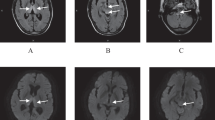Abstract
Transient cortical blindness (TCB) is a rare but striking complication following contrast agent injection. TCB might be secondary to a direct toxicity of the contrast agent, leading to an osmotic disruption of the blood–brain barrier (BBB), with a preferential involvement of the posterior circulation and occipital cortex. We report a series of three patients with contrast medium-associated TCB (intra-arterial injection of non-ionic contrast agent during diagnostic cerebral angiography for two of them and coronary angioplasty for the other one). In two patients, the magnetic resonance imaging (MRI) was unremarkable; in the other patient, typical MRI findings were observed, with FLAIR hyperintensities in the right occipital cortex and decreased apparent diffusions coefficient (ADC). Interestingly, this patient also presented posterior rhythmic epileptiform activities on electroencephalogram during the first 36 h. Visual evoked potentials (VEPs) showed normal retinal potential, but a massive destructuration of the later potentials of the cortical origin. To our knowledge, this is the first time that VEPs acquired during TCB are reported. We discuss these findings with respect to the pathophysiology of TCB.


Similar content being viewed by others
References
Sylverman SM, Bergman PS, Bender MB (1961) The dynamics of transient cerebral blindness. Report of nine episodes following vertebral angiography. Arch Neurol 4(3):333–348. doi:10.1001/archneur.1961.004500090099014
Suri V, Agarwal R, Jadhao N, Ahuja GK (2011) Cortical blindness after contrast-enhanced CT scan in a patient of sarcoidosis—is it related to posterior reversible encephalopathy syndrome? Ann Indian Acad Neurol 14(4):298–300. doi:10.4103/0972-2327.91956
Fischer-Williams M, Gottschalk PG, Browell JN (1970) Transient cortical blindness. An unusual complication of coronary angiography. Neurology 20(4):353–355
Mentzel HJ, Blume J, Malich A, Fitzek C, Reichenbach JR, Kaiser WA (2003) Cortical blindness after contrast-enhanced CT: complication in a patient with diabetes insipidus. AJNR Am J Neuroradiol 24(6):1114–1116
Merchut MP, Richie B (2002) Transient visuospatial disorder from angiographic contrast. Arch Neurol 59(5):851–854
Boyes LA, Tew K (2000) Cortical blindness after subclavian arteriography. Australas Radiol 44(3):315–317
Balasingam S, Azman RR, Nazri M (2016) Contrast media induced transient cortical blindness. QJM Month J Assoc Physicians 109(2):121–122. doi:10.1093/qjmed/hcv121
Saigal G, Bhatia R, Bhatia S, Wakhloo AK (2004) MR findings of cortical blindness following cerebral angiography: is this entity related to posterior reversible leukoencephalopathy? AJNR Am J Neuroradiol 25(2):252–256
Waldron RL 2nd, Bryan RN (1975) Effects of contrast agents on the blood-brain barrier. An electron microscopic study. Radiology 116(1):195–198. doi:10.1148/116.1.195
Borghi C, Saia F, Marzocchi A, Branzi A (2008) The conundrum of transient cortical blindness following coronary angiography. J Cardiovasc Med (Hagerstown, Md) 9(10):1063–1065. doi:10.2459/JCM.0b013e3282fe1718
Shinoda J, Ajimi Y, Yamada M, Onozuka S (2004) Cortical blindness during coil embolization of an unruptured intracranial aneurysm—case report. Neurol Med Chir 44(8):416–419
Niimi Y, Kupersmith MJ, Ahmad S, Song J, Berenstein A (2008) Cortical blindness, transient and otherwise, associated with detachable coil embolization of intracranial aneurysms. AJNR Am J Neuroradiol 29(3):603–607. doi:10.3174/ajnr.A0858
Hesp ZC, Zhu Z, Morris TA, Walker RG, Isaacson LG (2012) Sympathetic reinnervation of peripheral targets following bilateral axotomy of the adult superior cervical ganglion. Brain Res 1473:44–54. doi:10.1016/j.brainres.2012.07.033
Alp BN, Bozbuga N, Tuncer MA, Yakut C (2009) Transient cortical blindness after coronary angiography. J Int Med Res 37(4):1246–1251
Newman CB, Schusse C, Hu YC, McDougall CG, Albuquerque FC (2011) Acute transient cortical blindness due to seizure following cerebral angiography. World Neurosurg 75(1):83–86. doi:10.1016/j.wneu.2010.07.019
Author information
Authors and Affiliations
Corresponding author
Ethics declarations
Conflict of interest
The authors declare that they have no conflict of interest.
Ethical approval
All patients admitted in the university hospital consent that their clinical and imaging data can be used for publication or education purpose. All procedures performed were in accordance with the ethical standards of the institutional ethical committee and with the 1964 Helsinki declaration and its later amendments or comparable ethical standards.
Informed consent
All patients admitted consent that their clinical and imaging data can be used for publication or education purpose.
Rights and permissions
About this article
Cite this article
Baguma, M., Younan, N., London, F. et al. Contrast-associated transient cortical blindness: three cases with MRI and electrophysiology findings. Acta Neurol Belg 117, 195–199 (2017). https://doi.org/10.1007/s13760-016-0696-0
Received:
Accepted:
Published:
Issue Date:
DOI: https://doi.org/10.1007/s13760-016-0696-0




